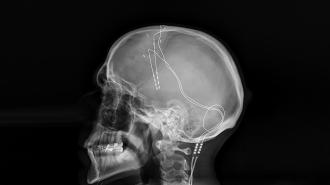UConn researchers have developed a deep brain stimulator that’s powered by breathing — potentially eliminating the need for patients to undergo regular surgeries to replace their devices’ dying batteries.
Deep brain stimulator: Our brain cells use electrical impulses to communicate. Sometimes, these cells fire in abnormal patterns or are less active than they should be, which can impair a person’s mood, memory, muscle control, and much else, depending on the part of the brain affected.
Deep brain stimulation — tiny electrical pulses delivered to the right place inside the brain — can sometimes correct this abnormal activity and alleviate symptoms associated with it.
Patients undergo surgery every 3 to 5 years to have the battery in their deep brain stimulator replaced.
To deliver the treatment, a surgeon implants one or more electrodes into a patient’s brain. A small battery-powered pulse generator, generally placed under the skin near the patient’s collarbone, then sends an electrical current to the electrodes via an implanted wire.
Depending on the level of stimulation, the patient will have to undergo surgery every 3 to 5 years to have the pulse generator’s battery replaced. While this surgery isn’t as complicated as the initial implantation, it still requires a hospital visit and puts patients at risk of infection.
Just breathe: UConn’s device has the potential to eliminate these surgeries.
It’s designed so that the natural inflation of a person’s lungs would press on an implanted “nanogenerator” that converts the movement into static electricity. The current from the nanogenerator charges a supercapacitor, which then powers the deep brain stimulator.
“This is the first system that combines all the pieces.”
Islam Mosa
A “simulated pig,” consisting of real pig lungs inside an artificial human rib cage, was used to demo the device. When the pig lungs were inflated with a pump, the movement generated enough power for a supercapacitor outside the ribs to pulse a deep brain stimulator 60 times a second.
“This is the first system that combines all the pieces: efficient energy harvesting, energy storage, and the controlled brain stimulator,” said co-corresponding author Islam Mosa.
The cold water: Most commercial deep brain stimulators deliver continuous stimulation, but the UConn team demonstrated intermittent stimulation only — for example, their device can operate continuously for 2 seconds, then pause for 8 seconds, then repeat.
However, recent animal studies suggest that intermittent stimulation might actually be a better approach for treating some conditions, such as memory loss, and researchers are still discovering new ways to use deep brain stimulation to treat a variety of disorders.
“If someone already has a deep brain stimulator, we could just replace the battery with this generator.”
Jim Rusling
The big picture: As of 2021, experts estimated that more than 200,000 people worldwide had undergone surgery to have a deep brain stimulator implanted.
If UConn’s device is able to prove itself in animal studies, human trials could follow — and if it works as hoped, the tech could potentially save thousands of people from having to undergo regular surgeries to have their deep brain stimulator charged.
“In principle, if someone already has a deep brain stimulator, we could just replace the battery with this generator without having to retrofit them with a wholly new device,” said co-corresponding author Jim Rusling.
We’d love to hear from you! If you have a comment about this article or if you have a tip for a future Freethink story, please email us at tips@freethink.com.
